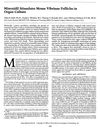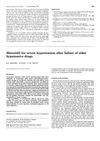TLDR Minoxidil helps hair growth by increasing blood flow and stimulating hair follicles.
Minoxidil, a drug used to treat severe refractory hypertension, was found to have a hair-growing effect in patients who experienced hypertrichosis during treatment. The mechanism of hair growth by minoxidil is not fully known, but it is believed to increase blood flow and stimulate hair follicle cells. The active metabolite of minoxidil for hair growth is thought to be minoxidil sulfate. In a study using mice, it was found that both minoxidil and minoxidil sulfate showed a hair-growing effect, with minoxidil sulfate being more potent. It was suggested that the hair-growing effect of minoxidil sulfate might be connected with the opening of potassium channels.
 121 citations
,
March 1989 in “Journal of Investigative Dermatology”
121 citations
,
March 1989 in “Journal of Investigative Dermatology” Minoxidil can help grow hair in mice by making cells grow and improving hair quality. More research needed.
 102 citations
,
September 1977 in “The Lancet”
102 citations
,
September 1977 in “The Lancet” Minoxidil with propranolol and diuretics lowers blood pressure but causes fluid retention and hair growth.
 86 citations
,
September 1977 in “BMJ”
86 citations
,
September 1977 in “BMJ” Minoxidil effectively controls blood pressure in severe cases, but has serious side effects and causes hair growth in women.
 3 citations
,
January 2018
3 citations
,
January 2018 A woman had an unusual allergic reaction to a hair loss treatment, which cleared up after stopping the treatment and using a different medication.
April 1985 in “Plastic & Reconstructive Surgery” Topical minoxidil can help regrow hair in alopecia areata but is less effective for severe cases.
 16 citations
,
April 1984 in “Archives of Dermatology”
16 citations
,
April 1984 in “Archives of Dermatology” Topical minoxidil can help hair regrowth in alopecia areata patients, but maintaining the growth after stopping treatment is inconsistent.





